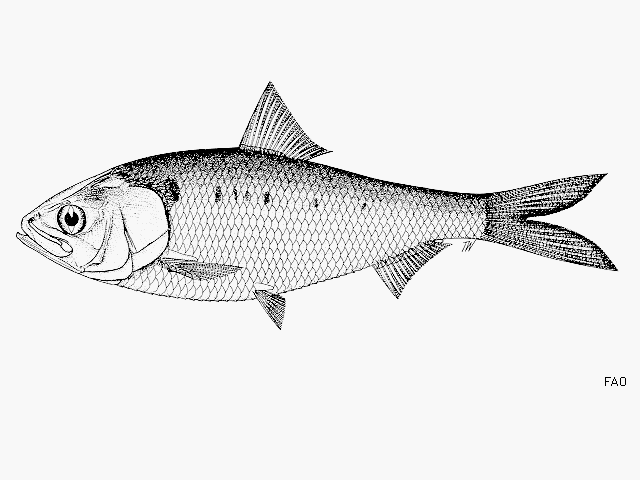| Dorosomatidae (Gizzard shads and sardinellas) |
| 61.6 cm TL (male/unsexed); max.weight: 5,000.0 g; max. reported age: 8 years |
|
pelagic-neritic; freshwater; brackish; marine; depth range 0 - 50 m, anadromous |
| Northwest Pacific: China and possibly southward into South China Sea, but records uncertain. Eastern Indian Ocean: two specimens collected from Phuket Island, Andaman Sea. The species thus overlaps Tenualosa toli in range. |
|
Dorsal spines (total): 3-3; Dorsal soft rays (total): 14-15; Anal spines: 2-2; Anal soft rays: 16-18; Vertebrae: 44-45. Belly with 29 to 34 scutes. Head large; a median notch in upper jaw, which distinguishes it from other similar clupeids, except Hilsa kelee; with a well developed sebaceous eyelids. Gill rakers fine and numerous, each raker with scattered asperities. Caudal fin deeply forked with minute scales. A dark blotch behind gill opening and a series of spots along flank. Color: Metallic blue-green back that lightens to silver along the sides (Ref. 45563). |
| Schooling in coastal waters and ascending rivers to breed. Adults are found near the surface at sea while larvae and juveniles spend the first two years of their life in river tide pools and estuaries (Ref. 57990). Feed on planktonic crustaceans like cyclopoids and other copepods, and rotifers (Ref. 45563). |
|
Data deficient (DD); Date assessed: 13 July 2017 Ref. (130435)
|
| harmless |
|
Widely distributed in near seas of China (Ref. 45563, 47843). In 1935, the species appeared in the Yangtze River during late spring and early summer for laying eggs. It was quite abundant at those times. The flesh is excellent and very famous (Ref. 35840). Decline of stocks mainly due to overfishing of the spawning parent and young fish (Ref. 45563). Introduced from its native range to other regions in the country (intensive culture and extensive stocking in ponds and rivers)(Ref. 55380). Also Ref. 35840.
Status of threat: Endangered (Ref. 45563). |
Source and more info: www.fishbase.org. For personal, classroom, and other internal use only. Not for publication.

